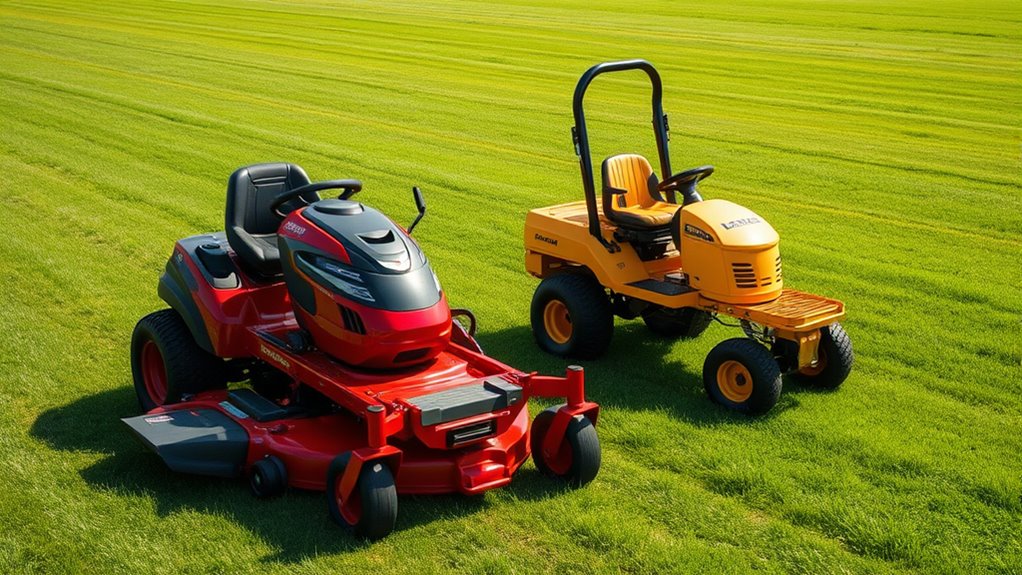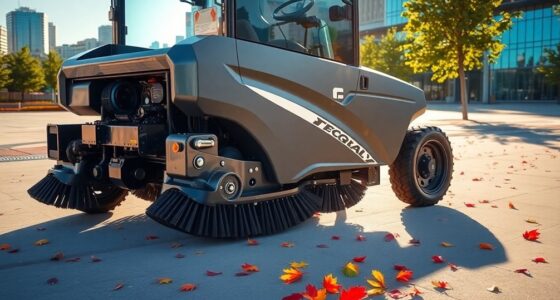If you’re weighing ride-on versus walk-behind mowers, consider your lawn size and how quickly you want to finish. Ride-on models cover more ground faster and are great for large areas, but they tend to have higher maintenance costs. Walk-behind mowers are better for small, intricate spaces and are easier to maneuver around obstacles. To make an informed choice that balances productivity, safety, and costs, look into the details below.
Key Takeaways
- Ride-on mowers cover larger areas faster due to bigger decks and higher speeds, boosting productivity on extensive lawns.
- Walk-behind mowers are more maneuverable for tight spaces, but take longer to complete large areas.
- Ride-on models reduce mowing time but may involve higher maintenance costs and complexity.
- Walk-behind mowers excel for small, intricate yards, offering ease of use and quick setup despite slower coverage.
- Terrain and obstacle navigation influence productivity, with ride-on mowers better for open, even terrains and walk-behinds suited for complex landscapes.

When choosing between a ride-on and a walk-behind mower, understanding their differences can help you make an informed decision. One of the key factors to consider is productivity tradeoffs, which directly influence how efficiently you can complete your mowing tasks. Ride-on mowers are designed for larger lawns and extensive areas, allowing you to cover more ground in less time. They feature larger cutting decks and higher speeds, making them ideal if you need to mow frequently or have a sizable property. On the other hand, walk-behind mowers are better suited for smaller yards or more intricate landscaping. They offer greater maneuverability around obstacles and tight spaces, but they generally take longer to finish the same job. Additionally, the choice between them can influence your overall cost-effectiveness and long-term satisfaction.
Safety considerations play a pivotal role in choosing between these types of mowers. Ride-on models tend to have more safety features like rollover protection, emergency shut-offs, and enclosed operator stations, which can reduce the risk of accidents. However, operating a ride-on mower requires more attention to safety protocols, especially on uneven terrain. Walk-behind mowers are simpler to operate and often involve fewer safety risks, but you still need to be cautious of blades and tripping hazards. Your comfort level and experience should influence your choice, as a more complex machine might require additional training or precautions.
Safety features vary; ride-ons have more but require careful operation on uneven terrain. Walk-behinds are simpler and safer.
Maintenance costs are another essential aspect affecting your decision. Ride-on mowers generally have higher maintenance costs because they are more complex machines with larger engines, more moving parts, and additional safety features. Regular upkeep, such as oil changes, blade sharpening, and engine servicing, can add up over time. Conversely, walk-behind mowers tend to have lower maintenance costs due to their simpler design and smaller engines. They are easier to repair or replace parts for, which can save you money in the long run. If budget constraints are a concern, this difference in maintenance costs might sway your choice toward a walk-behind mower.
Productivity tradeoffs between the two types boil down to your yard size, terrain, and personal preferences. If you prioritize speed and efficiency on large, open spaces, a ride-on mower offers significant advantages. But if you prefer a more versatile machine that’s easier to store and maintain, a walk-behind mower might be more suitable. Ultimately, balancing safety considerations and maintenance costs against your specific needs will help you select the mower that maximizes your productivity without sacrificing safety or breaking the bank.
Frequently Asked Questions
What Maintenance Differences Exist Between Ride-On and Walk-Behind Equipment?
You’ll find that ride-on equipment generally requires more extensive maintenance, like more frequent lubrication schedules for moving parts and hydraulic systems. Tire maintenance is also more involved, as ride-ons have larger, heavier tires that need regular inspection and inflation. Walk-behind equipment typically needs less maintenance overall, with simpler lubrication and smaller tires, making it easier to keep in good condition and reducing downtime.
How Do Safety Considerations Vary Between Ride-On and Walk-Behind Machines?
You need to prioritize safety protocols with both ride-on and walk-behind machines, but hazard awareness differs. With ride-on equipment, you should stay alert for rollover risks and ensure seat belts are used at all times. For walk-behind tools, focus on proper handling to avoid trips and falls. Always wear appropriate protective gear, follow manufacturer guidelines, and stay aware of your surroundings to prevent accidents and maintain safety.
Which Type Is More Environmentally Friendly Over Long-Term Use?
You’ll find that walk-behind machines tend to be more environmentally friendly over the long term, thanks to their electric efficiency and lower emissions footprint. While ride-on models often prioritize power, they usually consume more fuel and produce higher emissions. So, if reducing your environmental impact matters, opting for electric walk-behind equipment can make a significant difference, helping you operate sustainably while maintaining efficiency.
How Does Operator Fatigue Compare Between Ride-On and Walk-Behind Options?
You’ll likely experience lower fatigue levels with ride-on equipment because of its ergonomic design, which reduces strain on your muscles and joints. This setup allows you to work longer hours comfortably, unlike walk-behind models that require more physical effort and can cause quicker fatigue. With ride-on options, you benefit from increased comfort and less operator fatigue, helping you stay productive and focused throughout your workday.
What Are the Initial Costs Versus Long-Term Expenses for Each?
Imagine stepping onto a sleek ride-on mower, feeling the smooth glide across your lawn, versus pushing a walk-behind through thick grass. The initial costs of ride-on machines tend to be higher, but their long-term expenses often decrease with efficiency and reduced operator fatigue. Walk-behind options are cheaper upfront, yet you might face higher maintenance and labor costs over time, making the overall expenses a balancing act between budget and productivity.
Conclusion
Ultimately, whether you choose ride-on or walk-behind, your decision depends on your demands and your drive. Ride-ons deliver rapid results with less effort, perfect for larger jobs. Walk-behinds work well for tighter spaces and precision tasks. Weigh the workload, wonder about the width, and wonder no more—your ideal equipment awaits. With the right ride or walk, you’ll work wisely, winning the race against time and trouble. Pick your partner and propel productivity today!









